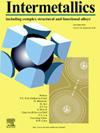High-temperature tensile and fatigue properties of Ti-48Al-2Cr-2Nb alloy additively manufactured via twin-wire directed energy deposition-arc
IF 4.3
2区 材料科学
Q2 CHEMISTRY, PHYSICAL
引用次数: 0
Abstract
Recently, additive manufacturing of titanium aluminide has attracted widespread attention. Since titanium aluminide is an ideal structure material for high-temperature, corresponding mechanical properties are of great significance. In present work, tensile properties from 25 °C to 1050 °C and fatigue properties at 650 °C were examined for the first time on twin-wire directed energy deposition-arc (TW-DED-arc) manufactured Ti-48Al-2Cr-2Nb (TiAl-4822) alloy. Importantly, fracture characteristics and deformation mechanisms were systematically investigated. Similar with extensively investigated titanium aluminide, TW-DED-arc manufactured TiAl-4822 alloy generally tends to decrease strength while increase elongation versus temperature during tensile process. Meanwhile, anomalous increase of strength is detected at 750 °C, and brittle-to-ductile transition temperature (BDTT) is around 850 °C. At 25 °C and 550 °C, γ/α2 lamellar interface and lamellar colony boundary as well as special microstructures are weak positions and susceptible to microcracking, and mechanical twining dominates deformation mode. By comparison, in temperature range of 650 °C–950 °C, γ/α2 interface and colony boundary are weaker, while deformation mechanism shifts to mechanical twinning and dislocation slip. Moreover, dynamic recrystallization (DRX) starts at 850 °C and further affects tensile behaviors, especially at 1050 °C. The fatigue limit (107 cycles) at 650 °C is approximately 335 MPa, ratio of which to tensile strength is calculated to be 0.71, indicating good fatigue resistance of as-manufactured TiAl-4822 alloy. Irrespective of stress level, crack prefer to initiate and propagate at γ/α2 interface and colony boundary. Both mechanical twining and dislocation slip are activated during fatigue process, but their morphologies vary with stress level. In sum, these findings provide a valuable reference for mechanical properties of additively manufactured titanium aluminide.
双线定向能沉积电弧增材制备Ti-48Al-2Cr-2Nb合金的高温拉伸和疲劳性能
近年来,铝化钛的增材制造引起了广泛的关注。由于铝化钛是一种理想的高温结构材料,其相应的力学性能具有重要意义。本文首次研究了双丝定向能沉积电弧(tw - d -电弧)制备的Ti-48Al-2Cr-2Nb (TiAl-4822)合金在25 ~ 1050℃的拉伸性能和650℃的疲劳性能。重要的是,系统地研究了断裂特征和变形机制。与广泛研究的铝化钛类似,在拉伸过程中,tw - d -电弧制造的TiAl-4822合金通常倾向于强度降低而伸长率增加。同时,在750℃时检测到强度的异常增加,脆性到延性转变温度(BDTT)在850℃左右。在25°C和550°C时,γ/α2片层界面和片层集落边界以及特殊的微观组织是易发生微裂纹的薄弱部位,变形方式以机械缠绕为主。在650℃~ 950℃温度范围内,γ/α2界面和群体边界变弱,变形机制转向机械孪晶和位错滑移。此外,动态再结晶(DRX)在850℃时开始,并进一步影响拉伸行为,特别是在1050℃时。在650℃下,钛合金的疲劳极限(107次循环)约为335 MPa,与抗拉强度之比为0.71,表明钛合金具有良好的抗疲劳性能。无论应力水平如何,裂纹都倾向于在γ/α2界面和群体边界处萌生和扩展。在疲劳过程中,机械缠绕和位错滑移都被激活,但其形态随应力水平的变化而变化。研究结果为增材制造铝化钛的力学性能提供了有价值的参考。
本文章由计算机程序翻译,如有差异,请以英文原文为准。
求助全文
约1分钟内获得全文
求助全文
来源期刊

Intermetallics
工程技术-材料科学:综合
CiteScore
7.80
自引率
9.10%
发文量
291
审稿时长
37 days
期刊介绍:
This journal is a platform for publishing innovative research and overviews for advancing our understanding of the structure, property, and functionality of complex metallic alloys, including intermetallics, metallic glasses, and high entropy alloys.
The journal reports the science and engineering of metallic materials in the following aspects:
Theories and experiments which address the relationship between property and structure in all length scales.
Physical modeling and numerical simulations which provide a comprehensive understanding of experimental observations.
Stimulated methodologies to characterize the structure and chemistry of materials that correlate the properties.
Technological applications resulting from the understanding of property-structure relationship in materials.
Novel and cutting-edge results warranting rapid communication.
The journal also publishes special issues on selected topics and overviews by invitation only.
 求助内容:
求助内容: 应助结果提醒方式:
应助结果提醒方式:


